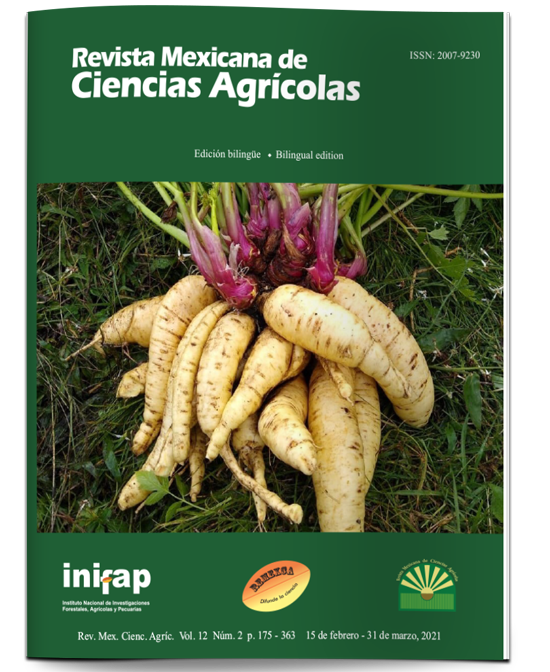Effectiveness of fungicides and Trichorderma spp. for the control of Lasiodiplodia spp. in ‘Persian’ lemon orchards in Veracruz
DOI:
https://doi.org/10.29312/remexca.v12i2.2551Keywords:
Lasiodiplodia spp., descending death, disease controlAbstract
The descending death of ‘Persian’ lemon (Citrus latifolia Tan.) caused by Lasiodiplodia spp., is a high-importance disease. The intensity of lemon pruning increases the susceptibility and annual loss of up to 35% of trees, resulting in 60% reduction in production. During 2016 and 2017, in the municipality of Papantla, Veracruz it was assessed the effectiveness of chemical and biological control against Lasiodiplodia spp., after pruning. A complete block design was performed at random; five treatments were applied: methyl thiophanate (1 g L-1), thiabendazole (2.5 g L-1), chlorothalonil (3 g L-1), mancozeb (4 g L-1), Trichoderma harzianum + Trichoderma viridae (20 ml L-1) and a witness (without application). Two sprays were made aimed at trunk, branches and foliage up to drip point. The incidence and severity of the disease was evaluated every seven days after the first application. With the data, epidemiological models were adjusted and descriptive parameters such as: initial intensity, rate of increase and area under the disease progress curve were calculated. Methyl thiophanate fungicide was most effective in disease control, followed by thiabendazole.
Downloads
Downloads
Published
How to Cite
Issue
Section
License
The authors who publish in Revista Mexicana de Ciencias Agrícolas accept the following conditions:
In accordance with copyright laws, Revista Mexicana de Ciencias Agrícolas recognizes and respects the authors’ moral right and ownership of property rights which will be transferred to the journal for dissemination in open access. Invariably, all the authors have to sign a letter of transfer of property rights and of originality of the article to Instituto Nacional de Investigaciones Forestales, Agrícolas y Pecuarias (INIFAP) [National Institute of Forestry, Agricultural and Livestock Research]. The author(s) must pay a fee for the reception of articles before proceeding to editorial review.
All the texts published by Revista Mexicana de Ciencias Agrícolas —with no exception— are distributed under a Creative Commons License Attribution-NonCommercial 4.0 International (CC BY-NC 4.0), which allows third parties to use the publication as long as the work’s authorship and its first publication in this journal are mentioned.
The author(s) can enter into independent and additional contractual agreements for the nonexclusive distribution of the version of the article published in Revista Mexicana de Ciencias Agrícolas (for example include it into an institutional repository or publish it in a book) as long as it is clearly and explicitly indicated that the work was published for the first time in Revista Mexicana de Ciencias Agrícolas.
For all the above, the authors shall send the Letter-transfer of Property Rights for the first publication duly filled in and signed by the author(s). This form must be sent as a PDF file to: revista_atm@yahoo.com.mx; cienciasagricola@inifap.gob.mx; remexca2017@gmail.
This work is licensed under a Creative Commons Attribution-Noncommercial 4.0 International license.



